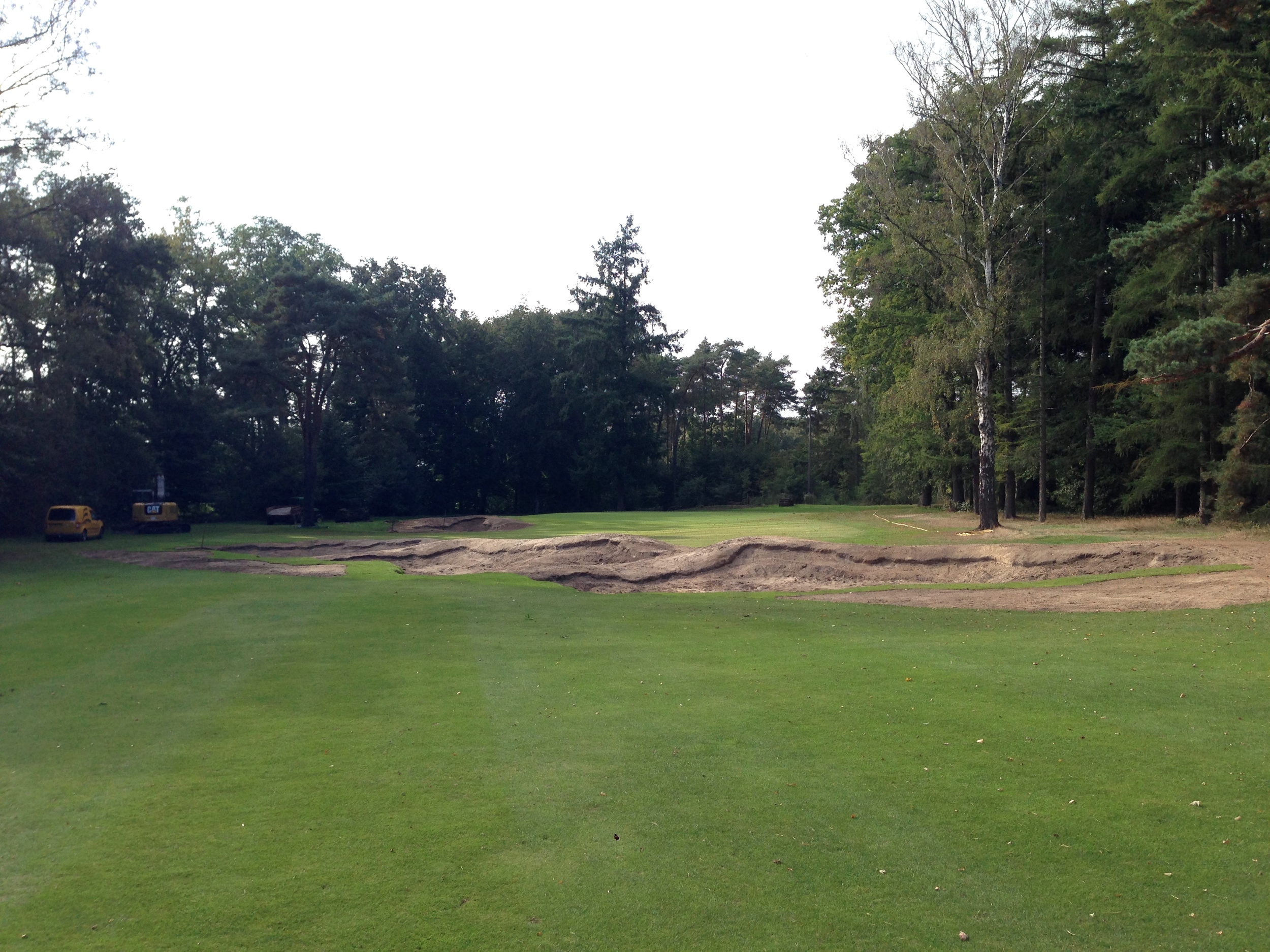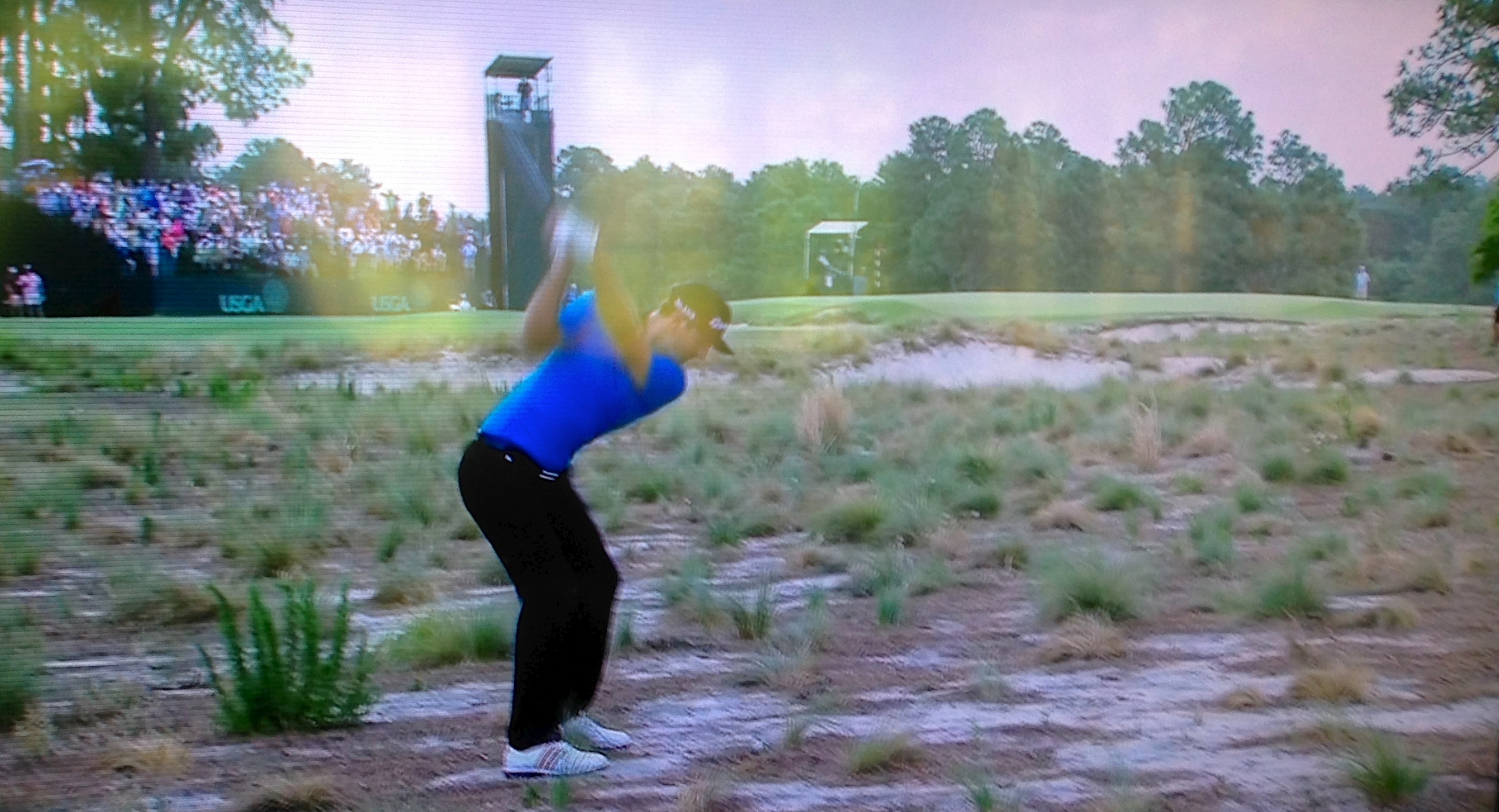This post is a continuation of the previous one, complete with before-and-afters of the recently completed bunker renovation by Hochstein Design and Frank Pont at the Sallandsche Golf Club. Due to the amount of images, I've split it up by nines. This is the back nine, beginning with the 10th, one of the original holes on the course (though like the rest, not quite in its original form).
The 10th is a medium long dogleg right par 4 that plays through large trees along the northern side of the sandy esker running through the middle of the property. Again there are two greenside bunkers, but these are more forward than most of the other other pre-existing bunkers. The plan was to fill in the left one and rebuild the right side one to get it closer to the green and open up some visibility. During the demo and digging, an opportunity was seen to create something different from the rest of the course using three-dimensionality. With a high point sticking up left, the bank on the right, and a new part in the middle low near the green, the bunker took on a look that is seen sometimes on sites where wind erodes sand. We wanted to get the front right part of the green more visible, and creating a sort of "blow-through" like this turned out to be a unique way to do it.
*Again, all before images credit to Frank Pont and Infinite Variety Golf Design*
Hole 10 before image with high right bunker blocking that whole part of the green and other bunker way out left on the property line.
The 10th hole after removing the left bunker and creating a new version of the right one with a blow-through that now gives a peek at the right corner of the green. Similar to the effect on 2 and 9, this bunker changes in depth and view as you move closer and around it.
The 10th hole bunker up close.
A view of the 10th bunker from the side walking up to the green showing how the bunker changes form as one walks past it. This is taken at the end of edging but before cleanup.
The 11th hole takes you across a two-track road onto the newest holes of the property designed by Donald Steel. A flat and completely open field when first acquired, there are now some trees on it, some of them good others not as good. It is a nice change of pace though to head into the open space after being mostly in the woods the first 10 holes. The hole itself is a par five with a slight dogleg right. There were initially two bunkers on the outside that are now one large one. Up by the green, there was a bunker in the left approach that was re-angled, a new bunker built at an angle to the right of it, a blind left greenside one filled in and made a hollow, and a blind right greenside one filled in and made much bigger and more visible toward the front. Needless to say, there was a lot going on at this hole.
Hole 11 fairway bunkers before. The view from the tees is vast, and making something to scale would be a challenge.
The zoomed in after view on 11. By building up a high peak in the middle and making it long, it just fits the vast open landscape. The 12th fairway bunker is just behind and to the left of it, and I shaped it to interact well with the one built on 11 and take up some space on the long plane.
A closer view of the fairway bunker on 11.
A before image of the 11th green approach shot. For most of the hole, the left greenside bunker was blind while the right one was always blind.
Hole 11 approach from 200 meters down the fairway. The right side bunker was built into the existing landforms built by someone else. For a short hitter trying to avoid a shot over a bunker, the gap is to the right short of the big one.
11 green closer up.
The 12th hole is a short dogleg right around the bordering woods and property line. There were initially a pair of circle shaped bunkers flanking each side of the fairway, and there were 3 greenside bunkers--two right and one left. The plan here called for eliminating the bunker on the right inside the dogleg, rebuilding the left bunker, and adding another bunker further down on the outside of the dogleg. This may seem a little counterintuitive to leave the inside of a dogleg undefended, but the reality is that it is defended by the work that went on up at the green, a green that also happens to fall slightly away and left. At the green we eliminated the left bunker and consolidated the two right greenside bunkers while also shifting it forward to cut off more of the angle from the right. The ideal play off the tee is then to drive it as close to the fairway bunkers and you can in order to get the good angle into the green.
Hole 12 fairway and green before
Hole 12 fairway after. The outside bunkers perfectly defend the ideal angle into the green.
Hole 12 green before
Hole 12 Green after with one of the simplest but in my opinion best looking bunkers on the course. The exposed dirt on the left above is a newly seeded hollow.
Hole 13 is another hole of substantial change. Like 12, it is a short par 4 bending to the right with circular fairway bunkers flanking both sides. Unlike 12, we flattened both fairway bunkers and instead built a small nasty bunker just off center in the middle of the fairway. Choosing which side to hit to is now dictated by the hole location following the work that went on at the green.
The green at 13 is probably the most dramatic and interesting on the golf course. It has a big left to right fall with a difficult-to-get-to high right side. A deep grass-faced bunker was on the right front of it and a low bunker was on the left side. Instead of doing the typical thing and maintaining the defense on the high right side with a bunker, that one was instead filled in and rounded off with excess material shaved down to further exaggerate the crown on the right side as well as help with the fill-in. With it to be short grass like the rest of the greens surrounds, it should make for very interesting approach and recovery shots.
The left side bunker was extended out to cut off the angle to the left side of the green. The advantage of this is that now to get the better angle to the lower left hole location, one must thread their tee shot between the centerline bunker and ditch down the right. When the hole is up high on the right though, the better place to be is in the left part of the fairway due to the slope of the green. 13 is now a great little hole.
Hole 13 before viewed from the beginning of the fairway
Hole 13 after from the further up the fairway. The exposed ground is the newly seeded flattened old bunker. Notice how much more prominent the high right side of the green is. That is the perfect example of addition by subtraction, for the green itself was not touched at all. Also notice how the angle to the hole is open from here.
Hole 13 from the left side of the fairway. This is the better angle to get at the high side of the green, but you can see how the bunker cuts off the angle of the low side hole location vs the other side of the fairway shown above.
Hole 13 green before. This image is also taken before the front right bunker was changed in-house in recent years.
Hole 13 green during work showing what the right side bunker was like at construction. Notice the extra landforms around the right.
Hole 13 green after. Notice the reduction of mounding on the right and how it makes the green more prominent.
Bonus image of the 13th green bunker showing how it changes form as it is encountered
The 14th hole is a par 3 through the trees and the only hole in the woods on this section of the property. Here the left bunker was filled in and made an undulating hollow, and the right bunker was rebuilt to be made visible. A second bunker was also added by Frank out in the field after the first (closer to the tee) bunker was dug and finished. This ended up enhancing not only the view from 14 tees but also from 16 fairway and green, which play toward the the 14th green from the right. That was a view we were also focused on from the beginning because of how prominent it is. It is a fun challenge making something look good from multiple angles, a skill that I enhanced working on Tom Doak's wide open Simapo Island in China.
Hole 14 before. Hard to believe, but there is a bunker over there on the right.
Hole 14 after. The second bunker behind was a late addition by Frank Pont. This is one of the few images unfortunately where the top lines of the shaping are clearly visible, but it can be seen that care was given to give nice variable movement of the ground and in this case make lines intersect and highlight the profile and depth of the set.
Hole 14 as viewed from the 16th green. Here the pair of bunkers also complement each other well.
The 15th hole is a pretty straightforward medium length par 4 with one of the flattest greens on the course. The one feature on the hole is a pond at the left in the landing area. With the scope of the work limited to bunkers and expanding grass lines, we keyed on that pond and made flirting with it on the tee shot the ideal play. The bunkers on the left of the green were eliminated and made a hollow while a little ridge was built to help balls from the left find the green while not really helping balls coming from the right. The right side bunker was made bigger and shifted slightly left, cutting off the angle from the right while leaving the left side still open.
Hole 15 before
Hole 15 after. The hollows on the left ended up being quite deep.
The 16th hole is a straightaway par 5 playing along the eastern boundary of the property and an open farm field that provides some nice long views on this hole and others out in this open section of the course. There were only two bunkers worked on at this hole, though it looks like more due to the bunkers of the 14th green in the background. The first is a fairway bunker in the left approach that was re-angled and built up. The second is the right greenside bunker that was dramatically reduced in size leaving only the section nearest the center of the green. The left side bunker was filled in, and the right side off the green was reshaped to interesting short game contours.
Hole 16 before from the left fairway bunker.
Hole 16 after from the left fairway bunker. Notice the bunkers of the 14th hole in the backdrop.
Hole 16 before nearer the green
Hole 16 green after
The 17th hole has been much talked about and photographed thus far, part because of its setting and result and part because it was the first hole completed and ready for photographs. In short, the hole is a short dogleg right with a series of three angled crossing bunkers and a small left greenside bunker. All of these bunkers were rebuilt in place, and another small bunker sitting blindly in the back was filled in and made a fall-off ridge.
Hole 17 the morning of project groundbreaking
Hole 17 on last day of project in December.
Hole 17 in sepia filter for fun to see how it compares with older styles of bunkers.
One more close-up view.
The back nine finishes the same as the front--with a par 3. This one is a bit longer though and downhill through a shoot of pines. The downhill nature of the hole made for an opportunity to do something a little different because the bunker would be sitting down below you versus on the horizon like most places on the course. Without the need to visually fade out into the ground, we made a big catcher's mitt sort of pit on the opposite (left) side of the existing right bunker, which we filled in and built up into some interesting contours that should catch some nice shadows from the clubhouse view. I like how the bunker turned out, and it will be interesting to see how it matures as heather from the left side is brought further in toward the bunker.
Hole 18 before from the tee.
Hole 18 after from the tees.
Hole 18 before from closer up.
Hole 18 after close up. Native and heather should eventually creep in from the left.
That concludes the review and photo tour of Sallandsche. All the comments, interest, and support have been much appreciated. Looking forward to seeing this work mature and get better, and looking forward to the next projects here in 2015 and beyond. Orinda CC for Todd Eckenrode and Origins Golf Design is next.






























































